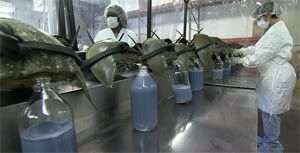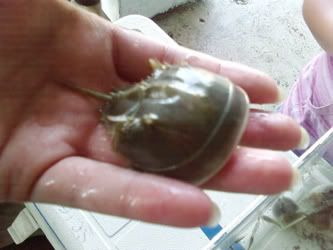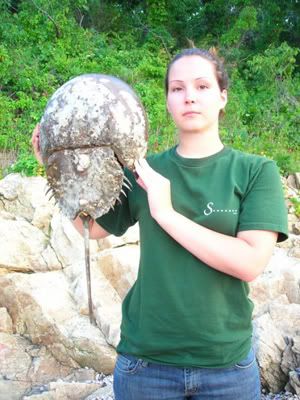
photo credit PBS
Limulus polyphemus; the horseshoe crab.
I have spent many a summer playing with these guys. I just love them to death, and have my whole life.

From the tiny...

...to the HUGE. Seriously, that thing is half the size of me.
To the stranger, they look a little weird - and perhaps even a bit scary - but these creatures won't hurt you. Can't even if they wanted to. That's not a stinger - it's just a tail, their claws are too weak to pinch you, and they don't have teeth.
On top of being harmless, and arguably adorable, they've also saved your life. Yep, yours.
Horseshoe crab blood is a standard in medical testing. Possessing unique clotting responses, the blood will clot around and effectively seal-off harmful toxic substances introduced to the immune system. The compound is called Limulus Amebocyte Lysate, or LAL.
"Today, LAL has become the worldwide standard screening test for bacterial contamination. Every drug certified by the FDA must be tested using LAL, as do surgical implants such as pacemakers and prosthetic devices."
LAL has meant the horseshoe crab has been thrown into the pharmaceutical market, and we all know that's big business. A quart of the blood - which is blue, due to a lack of hemoglobin and a presence of hemocyanin - is worth $15,000 and the industry is estimated at $50 million per year.
"Adult horseshoe crabs are collected by trawlers and transported to the LAL lab, where they are washed to remove sand and other marine debris from their exoskeletons. Those crabs without visible injuries are placed on a rack and bled with a large-gauge needle. Up to 30% of the crab’s blood is removed."
While the LAL industry claims that bleeding the crabs causes no long-term injury, recent studies have suggested otherwise. It takes about a week for the crab's blood volume to be restored, and several months to rebuild its blood cell count. There is up to a 15% mortality rate, which means 20,000 - 37,500 crabs die every year. Populations have lax fishing regulations, and it has become a concern among scientists that they may be declining.
Researchers are currently looking into a means of creating the LAL compound without bleeding the crabs.
I like the closing argument of this article:
"Perhaps science can step in and 'give back' to the animal for all of the good it has done us."
I hope so.
Full article here (PBS)
give mankind 2 years to destroy what nature has preserved for 200 million years
ReplyDeleteSad but true, my friend...
ReplyDelete